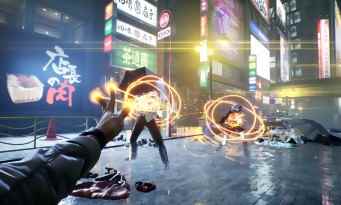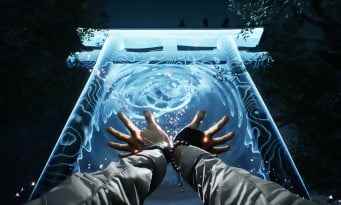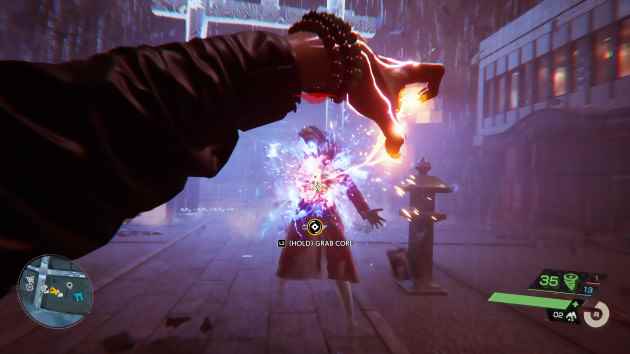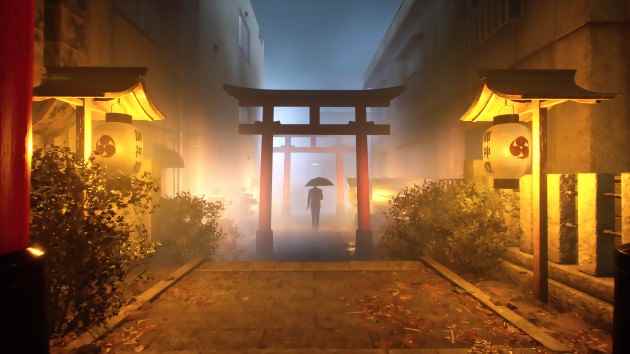Ghostwire: Tokyo will be released on March 25, which we sometimes tend to present a little quickly as a PS5 exclusive. To be more precise, the game will also be available next month on PC and, like a Deathloop also published by Bethesda Softworks, the console exclusivity will only be temporary. But let’s put aside these “political” considerations to focus on the game itself, which we had the pleasure of discovering during a presentation containing a long section of gameplay.
The storyline features Akito, a young man who has merged with a certain KK, the latter being an experienced ghost hunter turned spirit himself. This hero with a double personality discovers at the start of the game that all the inhabitants of the Tokyo district of Shibuya have disappeared, transformed into spirits by a mysterious fog, and that many and strange creatures from Japanese folklore have invaded the streets. Among these fantastic adversaries we were able to see disturbing faceless men wearing suits and umbrellas, a woman in red raincoat with a split mouth and giant scissors, or even headless schoolgirls. As you will have understood, we are dealing with an adventure with a strong emphasis on the supernatural. The developers would like to point out, however, that this is not a horror game. An understandable precision, since The Evil Within and The Evil Within 2 were until today the only two other productions of Tango Gameworks, a studio founded moreover by Shinji Mikami, the creator of Resident Evil.
But before addressing the substantive issues and gameplay mechanics, let’s take a few lines to discuss the game’s attractive artistic direction. Both colorful and realistic, it perfectly depicts the Tokyo atmosphere. We easily recognize the famous pedestrian crossings of the Shibuya crossroads or even the reddish tower of Tokyo, while many elements located “between tradition and modernity” offer us a real trip to the land of the Rising Sun. Paper lanterns, fluorescent neon lights, lucky cats, illuminated advertising signs, cherry blossoms and giant screens mingle harmoniously. Anyone who has ever been to Japan or enjoyed wandering the streets of the various Yakuza episodes can already bet a coin on Ghostwire: Tokyo. With a few surprises all the same, since the grocery stores open 24 hours a day are run by nekomata, that is to say feline spirits.
KOMOKONJU?
 If some cinematic scenes use an external camera, the game itself favors a subjective view, and can therefore reasonably be qualified as FPS. However, Akito a priori does not use any firearms. The arsenal seems to be essentially composed of a relatively classic bow and a power called Ether Weaving with multiple effects (wind, water, fire…). It allows the hero to shoot different projectiles with his hands, but also to “weave” between his fingers a luminous thread capable of tearing out the hearts of enemies. Note, however, that the visual effects don’t really lean towards gore but are instead made up of digital artifacts, such as virtual tetrahedrons and other pixelated wounds. These details seem to indicate that we find ourselves in a sort of matrix, the presence of telephone booths with an important role being certainly a reference to the Wachowski film. These cabins free the spirits of the inhabitants, who will regain their human form once transferred to the other end of the line. To do this, you must first absorb these spirits in a paper figurine, and therefore face the creatures that keep them. For example, we witnessed a sequence where the men with the umbrella mentioned above kept spirits imprisoned in a giant box with a design similar to the Hellraiser cube. The direct approach is not the only one possible, because the game also offers a small infiltration mechanic based on crouching and “quick purge” (the equivalent of stabbing or strangulation in adventures more classic). Spectral vision is also available, the latter of which can be used to track silhouettes of the past or view important objects through walls. The presence of a grappling hook indicates that a certain verticality will be required, especially since falling from a height apparently does not cause any damage to the hero.
If some cinematic scenes use an external camera, the game itself favors a subjective view, and can therefore reasonably be qualified as FPS. However, Akito a priori does not use any firearms. The arsenal seems to be essentially composed of a relatively classic bow and a power called Ether Weaving with multiple effects (wind, water, fire…). It allows the hero to shoot different projectiles with his hands, but also to “weave” between his fingers a luminous thread capable of tearing out the hearts of enemies. Note, however, that the visual effects don’t really lean towards gore but are instead made up of digital artifacts, such as virtual tetrahedrons and other pixelated wounds. These details seem to indicate that we find ourselves in a sort of matrix, the presence of telephone booths with an important role being certainly a reference to the Wachowski film. These cabins free the spirits of the inhabitants, who will regain their human form once transferred to the other end of the line. To do this, you must first absorb these spirits in a paper figurine, and therefore face the creatures that keep them. For example, we witnessed a sequence where the men with the umbrella mentioned above kept spirits imprisoned in a giant box with a design similar to the Hellraiser cube. The direct approach is not the only one possible, because the game also offers a small infiltration mechanic based on crouching and “quick purge” (the equivalent of stabbing or strangulation in adventures more classic). Spectral vision is also available, the latter of which can be used to track silhouettes of the past or view important objects through walls. The presence of a grappling hook indicates that a certain verticality will be required, especially since falling from a height apparently does not cause any damage to the hero.
LAND OF CONTRASTS, BETWEEN LINEARITY AND OPENNESS
 During the part shown to us, the hero also twice drew signs in the air, either to open a magically sealed door or to exorcise a malevolent spirit. The interface elements displayed on the screen seem to indicate that it is possible to draw the line “by hand” (with the joystick, what) or to let KK take care of it automatically. We also witnessed a passage inside a building threatened by a kind of digital barrier ready to crush it. To get out of it, Akito had to break three magic stones more or less hidden in the scenery. The strong point of this sequence is undoubtedly its staging, which plays with the perception of reality thanks to moving objects, transparent walls, a large room located in a closet, toilets fixed to the wall, floating furniture, and upside-down sets forcing us to walk on the ceiling. This passage felt heavily (but effectively) scripted to us, while the overall progression of the hero from objective to objective felt fairly linear. But this point is most certainly due to the fact that the extract that was shown to us essentially corresponds to the beginning of the adventure. The presence of a map displaying numerous points of interest (secondary missions, torii gates to free, fast travel points, etc.), as well as that of menus dedicated to equipment and a talent tree, indicate on the contrary that we will be entitled to a real small open world.
During the part shown to us, the hero also twice drew signs in the air, either to open a magically sealed door or to exorcise a malevolent spirit. The interface elements displayed on the screen seem to indicate that it is possible to draw the line “by hand” (with the joystick, what) or to let KK take care of it automatically. We also witnessed a passage inside a building threatened by a kind of digital barrier ready to crush it. To get out of it, Akito had to break three magic stones more or less hidden in the scenery. The strong point of this sequence is undoubtedly its staging, which plays with the perception of reality thanks to moving objects, transparent walls, a large room located in a closet, toilets fixed to the wall, floating furniture, and upside-down sets forcing us to walk on the ceiling. This passage felt heavily (but effectively) scripted to us, while the overall progression of the hero from objective to objective felt fairly linear. But this point is most certainly due to the fact that the extract that was shown to us essentially corresponds to the beginning of the adventure. The presence of a map displaying numerous points of interest (secondary missions, torii gates to free, fast travel points, etc.), as well as that of menus dedicated to equipment and a talent tree, indicate on the contrary that we will be entitled to a real small open world.


